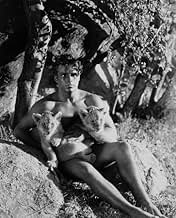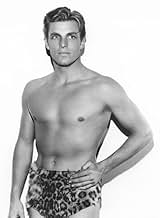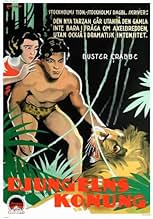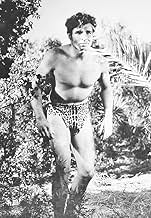IMDb RATING
6.2/10
256
YOUR RATING
A white youth who is raised in the jungle by the animals is captured by a safari and brought back to civilization as an attraction in a circus.A white youth who is raised in the jungle by the animals is captured by a safari and brought back to civilization as an attraction in a circus.A white youth who is raised in the jungle by the animals is captured by a safari and brought back to civilization as an attraction in a circus.
Douglass Dumbrille
- Ed Peters
- (as Douglas Dumbrille)
Ronnie Cosby
- Kaspa at age three
- (as Ronnie Cosbey)
Robert Adair
- John C. Knolls
- (uncredited)
Florence Britton
- Mrs. Edith Knolls
- (uncredited)
Don Brodie
- Reporter
- (uncredited)
Leonard Carey
- Clerk at Hunting License Bureau
- (uncredited)
Nora Cecil
- Spinster in Park
- (uncredited)
Featured reviews
I saw this film only once, at the age of seven, in 1933. Even allowing for the fact that we saw fewer films then and that seven is an impressionable age,"King of the Jungle" was exceptional. Many of its powerful cinematic images have remained as active and vivid memories throughout my life, now into my 80's.
Overall the film posits a romantic, if unrealistic, idea of an intelligent, informed and physically able man who lives at ease within a natural environment and amongst its wild inhabitants. This idealised image, modified and matured over a lifetime has influenced my values and those of my family for many years. None of us can escape the thought that our environment may call us to account at any time and require us to meet similar demands.
Early in the film we see the father of a small family arranging for them to fly over a nearby jungle in a light aircraft. While he is preoccupied at the desk his small son behind him, apparently moved by curiosity, gently takes his father's knife from its sheath at the back of his belt. The knife remains with the boy long after he is the sole survivor of the subsequent plane crash in the jungle. As he grows up this tool remains his one concession to modern technology.
We see the orphaned boy playing with some young lion cubs in a clearing and when the mother lioness returns he crawls on all fours with his companions into a cave like lair, calmly followed by the lioness. We next see him fully grown, with the convincing physique of Buster Crabbe, at ease not only with lions but with all creatures. Later action-scenes illustrate and reinforce the idea of a well developed, athletic man in harmony with a respectful animal kingdom.
This happy natural order of things is shattered when Kaspa is captured by a group of hunters, commissioned by a circus to "bring back alive" a variety of wild animals. This they intend to do but his captors do not know what to make of the unique and frightening specimen, Kaspa. Stout wooden cages are erected for the different breeds on the deck of their ship and the "savage" is locked in one by himself. As the laden ship approaches its destination a customs official comes aboard to examine the cargo. He declares that Kaspa is undeniably human and must be released from his animal cage. On the instant of his release, Kaspa takes one step onto the gunwale and entirely without hesitation, dives into the sea, which of course, holds no fear for him. The shocking and explosive speed of his action remain an indelible memory.
Having thus escaped he makes for the shore and enters a comfortable dwelling which is full of strange and intriguing objects, but he is familiar enough with the contents of a goldfish bowl to take a modest drink from it. When interrupted, he hides behind a convenient screen but the lady of the house sees his bare feet under it and he is revealed. Hilarious for a seven year old! He continues to show his doubts about civilisation and his preference for things natural, but he is disarmed by the female of his species and he is persuaded to appear in a circus act with his lions. He astounds everyone when he refuses to take a pistol into the caged ring. He emerges from the action as morally superior. The film ends with Kaspa and his lady, both fully dressed in sun hats and whites, returning to the Jungle and we are left to speculate whether they can make it as its King and Queen.
Although not nominally a Tarzan film, as an evocation of the ideal of the noble savage, this memorable film is closer to the spirit of Burroughs's writing than many of the later films which bear the Tarzan title.
You will understand that I am delighted to learn that it is now possible to purchase a copy of "King of the Jungle 1933" from TVideo.com
John Fulton 2007
Overall the film posits a romantic, if unrealistic, idea of an intelligent, informed and physically able man who lives at ease within a natural environment and amongst its wild inhabitants. This idealised image, modified and matured over a lifetime has influenced my values and those of my family for many years. None of us can escape the thought that our environment may call us to account at any time and require us to meet similar demands.
Early in the film we see the father of a small family arranging for them to fly over a nearby jungle in a light aircraft. While he is preoccupied at the desk his small son behind him, apparently moved by curiosity, gently takes his father's knife from its sheath at the back of his belt. The knife remains with the boy long after he is the sole survivor of the subsequent plane crash in the jungle. As he grows up this tool remains his one concession to modern technology.
We see the orphaned boy playing with some young lion cubs in a clearing and when the mother lioness returns he crawls on all fours with his companions into a cave like lair, calmly followed by the lioness. We next see him fully grown, with the convincing physique of Buster Crabbe, at ease not only with lions but with all creatures. Later action-scenes illustrate and reinforce the idea of a well developed, athletic man in harmony with a respectful animal kingdom.
This happy natural order of things is shattered when Kaspa is captured by a group of hunters, commissioned by a circus to "bring back alive" a variety of wild animals. This they intend to do but his captors do not know what to make of the unique and frightening specimen, Kaspa. Stout wooden cages are erected for the different breeds on the deck of their ship and the "savage" is locked in one by himself. As the laden ship approaches its destination a customs official comes aboard to examine the cargo. He declares that Kaspa is undeniably human and must be released from his animal cage. On the instant of his release, Kaspa takes one step onto the gunwale and entirely without hesitation, dives into the sea, which of course, holds no fear for him. The shocking and explosive speed of his action remain an indelible memory.
Having thus escaped he makes for the shore and enters a comfortable dwelling which is full of strange and intriguing objects, but he is familiar enough with the contents of a goldfish bowl to take a modest drink from it. When interrupted, he hides behind a convenient screen but the lady of the house sees his bare feet under it and he is revealed. Hilarious for a seven year old! He continues to show his doubts about civilisation and his preference for things natural, but he is disarmed by the female of his species and he is persuaded to appear in a circus act with his lions. He astounds everyone when he refuses to take a pistol into the caged ring. He emerges from the action as morally superior. The film ends with Kaspa and his lady, both fully dressed in sun hats and whites, returning to the Jungle and we are left to speculate whether they can make it as its King and Queen.
Although not nominally a Tarzan film, as an evocation of the ideal of the noble savage, this memorable film is closer to the spirit of Burroughs's writing than many of the later films which bear the Tarzan title.
You will understand that I am delighted to learn that it is now possible to purchase a copy of "King of the Jungle 1933" from TVideo.com
John Fulton 2007
During the 1930s-60s, Hollywood made a ton of Tarzan and Tarzan knockoff movies. A few of the Tarzan films (especially the ones with Johnny Weissmuller) were excellent...and most of the rest were pretty crappy...particularly the knockoffs. These knockoff and crappy Tarzan pics abound with terrible stock footage (often of animals not even native to Africa) and the plots are, to put is charitably, pretty dull. In light of this, I was shocked how much I enjoyed "King of the Jungle", a knockoff all the way...but a wonderful knockoff.
The story starts out pretty much like Tarzan. Some parents bring their very young child to the African savannahs in order to go sightseeing. However, they are killed and the child is but a toddler. But instead of apes adopting the child, it's adopted by a lioness!! Now don't start complaining about how 'that's not possible'....it's not like it's very likely gorillas would successfully raise a child either!
The child grows into a man (Buster Crabbe) and he is at home with all the lions. However, when some folks come to the savannah looking for lions, they accidentally also capture the young man. He is given the name 'Kaspa the Lion Man' and is taken to America in a cage!! Not surprisingly, he soon escapes but manages to meet a nice lady (Frances Dee) and she is able to convince him to go back with the folks...and she is hired to take care of him. Soon, Kaspa has learned to talk and is a bright, handsome guy....and he has a strong affinity for lions. He becomes the ultimate circus lion tamer--doing his job with no whip, no chair, no gun...just love for the animals. What's next? See the film....you won't be unhappy.
This film is not without problems. The most obvious is the similarlity to Tarzan. It's too similar in spots and is truly a knockoff. There also are some godawful staged fights...such as when they have a bull and lion spar each other as well as later in the film when a lion and tiger fight. I don't think any of the animals were killed or seriously injured....at least in the footage you see...though it is cruel and irresponsible. However, it also has some amazingly good qualities....no crappy stock footage(!!!), a breathtaking finale at the circus as well as a wonderful and sweet ending. Overall, a lot more good than bad in this one...and it's no wonder Crabbe's next film was a movie serial...."Tarzan the Fearless".
The story starts out pretty much like Tarzan. Some parents bring their very young child to the African savannahs in order to go sightseeing. However, they are killed and the child is but a toddler. But instead of apes adopting the child, it's adopted by a lioness!! Now don't start complaining about how 'that's not possible'....it's not like it's very likely gorillas would successfully raise a child either!
The child grows into a man (Buster Crabbe) and he is at home with all the lions. However, when some folks come to the savannah looking for lions, they accidentally also capture the young man. He is given the name 'Kaspa the Lion Man' and is taken to America in a cage!! Not surprisingly, he soon escapes but manages to meet a nice lady (Frances Dee) and she is able to convince him to go back with the folks...and she is hired to take care of him. Soon, Kaspa has learned to talk and is a bright, handsome guy....and he has a strong affinity for lions. He becomes the ultimate circus lion tamer--doing his job with no whip, no chair, no gun...just love for the animals. What's next? See the film....you won't be unhappy.
This film is not without problems. The most obvious is the similarlity to Tarzan. It's too similar in spots and is truly a knockoff. There also are some godawful staged fights...such as when they have a bull and lion spar each other as well as later in the film when a lion and tiger fight. I don't think any of the animals were killed or seriously injured....at least in the footage you see...though it is cruel and irresponsible. However, it also has some amazingly good qualities....no crappy stock footage(!!!), a breathtaking finale at the circus as well as a wonderful and sweet ending. Overall, a lot more good than bad in this one...and it's no wonder Crabbe's next film was a movie serial...."Tarzan the Fearless".
This 1933 pre-code antique is a delight on several levels. For once, it's a jungle movie from the early thirties when MGM's Johnny Weismuller was bringing in the money as that studio's Tarzan. So, Paramount wanted some of the jungle action and created this very enjoyable variation of the wild boy raised in the jungle by wild animals.
I've always felt Buster Crabbe was terribly under-rated. Here he is in all his near naked glory as Kaspa, the Lion King. We're never really explained as to how he escaped a wrecked plane and managed to grow up into this radiant Adonis but since this movie was made before the production code, we get to see lots of Buster since he wears a bikini sling-shot so abbreviated that he really is virtually naked, except for his rear-end. In fact, the movie's ads were aimed primarily at the women audience members at their chance to see a beautiful Adonis in the near altogether as this jungle god.
The cast is surprisingly strong with excellent production values, camera work and editing. The best part of the movie by far is the huge circus fire at the end. Not sure how they did this but the fleeing circus patrons look genuinely terrified and Buster is in his glory as he breaks through the police lines to rescue his beloved cats.
There is naturally a love story to all this and Francis Dee makes a delightful choice as a school teacher who see's the real potential of this jungle boy when he invades her apartment. She takes him under her wing and travels with the circus to support and educate him.
This was Buster's first movie, fresh from winning major swimming olympic awards and his natural beauty is spell-bounding. His torso is beautifully proportioned, he sports a thick head of dark curls and his face is as innocent and boyish as one would expect of a young male suddenly thrust from the jungle into the wilds of a big city.
This quality of wide-eyed innocence is what new audiences are discovering about Buster Crabbe as they watch him in "Flash Gordon", his various serials and especially another jungle yarn, "Tarzan the Fearless" in which he reprises his identical bikini slingshot and makes a very appealing young Tarzan.
A British man, his wife, and their small boy go into the jungle. The adults are killed, but the boy is succored by lions to grow up to be Buster Crabbe. Discovered by men hunting for animals for the circus, he is captured and sold to Sidney Toler, who calls him Kaspa the Griendly Ghost.... I mean the Lion Man. When the ship pulls into San Fracisco, Crabbe escapes, but finds a refuge at the home of schoolteacher Frances Dee and her sister, Nydia Westman. Toler takes Miss Dee along, since Crabbe likes her, and she gradually teaches him English and falls in love with him.
H. Bruce Humberstone directs Paramount's answer to TARZAN THE APE MAN, and while the story is very different, the characters fall into the same roles as in Burroughs' story. There are some nice circus bits, and of course, a big fire, with the elephants escaping into town. It's certainly not particularly brilliant, but it is the sort of solid, entertaining story that the majors could turn out in the period. With Robert Barratt, Irving Pichel, and Douglas Dumbrille.
H. Bruce Humberstone directs Paramount's answer to TARZAN THE APE MAN, and while the story is very different, the characters fall into the same roles as in Burroughs' story. There are some nice circus bits, and of course, a big fire, with the elephants escaping into town. It's certainly not particularly brilliant, but it is the sort of solid, entertaining story that the majors could turn out in the period. With Robert Barratt, Irving Pichel, and Douglas Dumbrille.
Paramount's answer to Tarzan, with Olympic athlete Buster Crabbe as a child raised to adulthood by a pride of lions. The expected complications result when Buster and his furry pals are transported to a circus. Charmingly clumsy in its early scenes, the film builds to an exciting, fiery conclusion. Animal activists will wince at a brutal battle between some big cats, but otherwise it's very entertaining.
Did you know
- TriviaBuster Crabbe narrowly lost the role of Tarzan to Johnny Weissmuller, so he starred in this Tarzan "copycat" film.
- GoofsBiggest plot hole is that a human being can not be bought and sold else it is human trafficking, illegal under international law. Also he could not enter or leave any country without a passport.
- ConnectionsEdited into Caged Fury (1948)
Details
- Runtime1 hour 13 minutes
- Color
- Aspect ratio
- 1.37 : 1
Contribute to this page
Suggest an edit or add missing content

Top Gap
By what name was Kaspa, le roi de la jungle (1933) officially released in India in English?
Answer






















